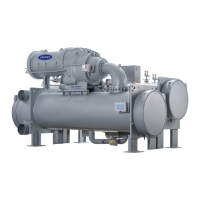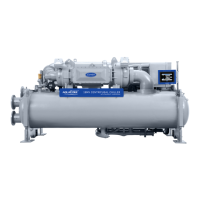19
monitors starter inputs such as line voltage, motor current,
ground fault, remote start contact, spare safety, condenser high
pressure, oil pump interlock, starter 1M, and run contacts. It
shuts down the chiller if communications with the ICVC are
lost. The ISM can also act as the interface for PIC II to the VFD
controller.
The ISM module directly measures current and voltage for
each phase. Calculation of power factor, power in kilowatts,
and energy in kilowatt hours is performed by software in the
ISM for constant speed starters only. All of these values are
transmitted to the ICVC on the SIO (sensor input/output) com-
munications bus. The ISM software also defines conditions for
transition for different starter types, and it integrates I
2
t in mon-
itoring motor overload.
CHILLER CONTROL MODULE (CCM) — This module is
located in the control panel. The CCM provides the input and
outputs necessary to control the chiller. This module monitors
refrigerant pressure, entering and leaving water temperatures,
and outputs control for the guide vane actuator, oil heaters, and
oil pump. The CCM is the connection point for optional de-
mand limit, chilled water reset, remote temperature reset, re-
frigerant leak sensor and motor kilowatt output.
OIL HEATER CONTACTOR (1C) — This contactor is lo-
cated in the power panel (Fig. 14) and operates the heater at ei-
ther 115 or 230 v. It is controlled by the PIC II to maintain oil
temperature during chiller shutdown. Refer to the control panel
wiring schematic.
OIL PUMP CONTACTOR (2C) — This contactor is locat-
ed in the power panel. It operates all 200 to 575-v oil pumps.
The PIC II energizes the contactor to turn on the oil pump as
necessary.
HOT GAS BYPASS CONTACTOR RELAY (3C)
(OPTIONAL) — This relay, located in the power panel, con-
trols the opening of the hot gas bypass valve. The PIC II ener-
gizes the relay during low load, high lift conditions.
CONTROL TRANSFORMERS (T1, T2) — These trans-
formers convert incoming control voltage to 24 vac power for
the 3 power panel contactor relays, CCM, and ICVC.
SENSORS — Three types of temperature sensors are used.
Figure 15 shows a typical temperature sensor for which
sensor wells are not used, in systems having an ICVC control-
ler. For this type, the sensor cable can be easily disconnected
from the sensor, which is in direct contact with the fluid.
The other typical temperature sensor has sensor wells. See
Fig. 16. For this type, the sensor cable cannot be separated
from the sensor itself, but the sensor can be easily removed
from the well without breaking into the fluid boundry.
The third type of temperature sensor is a thermistor, which
is installed either in the motor windings or at the thrust bearing
within the compressor. Both of these have redundant sensors
such that if one fails, the other can be connected external to the
machine. See Table 2 for a list of standard instrumentation sen-
sors.
The PIC II control determines refrigerant temperature in the
condenser and evaporator from pressure in those vessels, read
from the corresponding pressure transducers. See Fig. 14. The
pressure values are converted to the equivalent saturation tem-
peratures for R-134a refrigerant. When the chiller is running, if
the computed value for EVAPORATOR REFRIG TEMP is
greater than, or within 0.6° F (0.33° C) of the LEAVING
CHILLED WATER temperature, its value is displayed as 0.6° F
(0.33° C) below LEAVING CHILLED WATER temperature.
When the chiller is running, if the computed value for CON-
DENSER REFRIG TEMP is less than, or within 1.2° F
(0.67° C) of the LEAVING COND WATER temperature, its val-
ue is displayed as 1.2° F (0.67° C) above LEAVING COND
WATER temperature.

